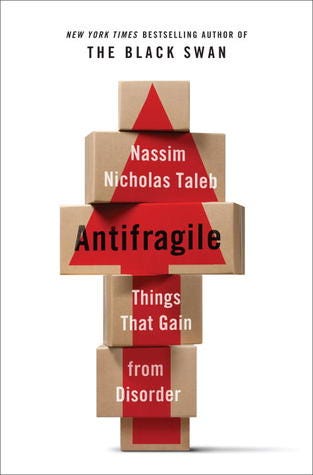How To Turn Difficult Times into Opportunities for Personal Growth
Lessons from experts on how to be resilient and bounce back from the challenges life throws at you

Lessons from experts on how to be resilient and bounce back from the challenges life throws at you
Adversity is the crucible that tests your will. And the worst part is: you cannot escape adversity, no matter how hard you try. Sooner or later, all of us have to face difficult moments.
Your budding business might fail, the book you’re working on might not resonate with the audience, your marriage might fizzle off, or you might be thrown out of that cushy, comfortable job you’re in right now.
You can’t change your destiny. But you can change the way you react to it.
Proper training of the mind, body, and spirit can help you achieve resilience and better equip you to confront life’s ups and downs.
Learning to Be Antifragile

I was going through a phase of significant change on the personal front when I came across this brilliant book Antifragile: Things That Gain from Disorder by Nassim Nicholas Taleb. In it, the author discusses the concept of resilience as the ability to withstand difficulties without breaking.
The book introduces the term antifragile as the ability of a person not just to resist shocks but to use them as a launchpad to become a better, more robust version of themselves. You can become antifragile when you learn to turn a catastrophe into an opportunity for personal growth.
Taleb discusses a three-step strategy to turn every misfortune into an opportunity. His approach has helped me rethink some of my worst personal failings and visualise them as chances to make myself better. As the author quotes,
“Difficulty is what wakes up the genius.”
In this article, I am going to share the critical facets of Taleb’s formula on how I learned from them to be antifragile. You can apply them in your life to not let setbacks deter you from pursuing your goals.
Step 1: Create Options
I have always wanted to quit my job and pursue writing full-time. The only problem stopping me was that even though I had published three books, the income I made from the sales was not enough to sustain my monthly expenses. I found this demotivating and always wondered: if the sales go on this way, how am I ever going to quit my job and focus my time and energy on writing?
That is when I read Taleb’s book and the key lesson of having multiple options resonated with me.
The power of creating options
According to the author, it is best to not focus all your energy on one source of income. Have a side hustle and try to create multiple channels of revenue so that even if one of them fails by a stroke of bad luck, you are not rendered destitute.
In the same way, when it comes to the personal sphere, don’t make your partner the centre of your life so that if the relationship does not work, you don’t lose everything. Instead, cultivate meaningful friendships and a life full of hobbies along the way, so you will be in a better position to move on and rebuild your life after a falling out.
You might think that your job is secure, and starting a business will be a drain on time you are already short on.
Or that your relationship is rock-solid and it is meaningless to have any other friends when your partner is all you need.
This false sense of security might have lulled you into believing the comfortable status quo will last forever. As Taleb argues,
“Success brings an asymmetry: you now have a lot more to lose than to gain. You are hence fragile.”
It is essential to understand life is unpredictable and unexpected things that you wouldn’t have imagined in your wildest dreams can happen to anyone. It is better to be prepared for them than to live in denial and be taken by surprise when misfortune befalls.
How I applied this lesson
When it came to my dream of becoming a full-time writer, I understood that it would indeed be hard if I seek to make a living off my book sales alone. If I intended to have a good life, I needed to have other sources of income, and that is okay. I started exploring other options (Medium is one of them!) and so far, things have worked out great.
If all goes well and a couple of my options keep generating a steady income as they are doing right now, I might be able to quit my job by the end of this year!
Step 2: Take Calculated Risks
I am not an expert in personal finance. But, I do understand that if I plan to live my life doing something as volatile as writing, I need to have a steady source of passive income. I consulted with a friend who works in the investment banking sector, and she suggested that I invest in mutual funds. The first few schemes I heard sounded so lucrative, my first instinct was to splurge all my savings on them
What she told me next complements the second tenet of Taleb’s model.
Bet keeping the risks in mind
The secret to becoming antifragile is to take small risks that might give great returns without exposing yourself to dangers big enough to sink you.
A perfect example to elucidate this concept can be given by considering the world of finance.
Let’s say; you have $100,000 saved up that you plan to invest in stocks. You invest $80,000 into a fixed-deposit, and the remaining $20,000 in ten start-ups with potential for tremendous growth, say $2000 each.
A possible scenario is that three of the companies you invested in fail completely, and you lose $6000. The values of three other companies go down, and you lose another $4000. The values of three others go up, and you gain $2000, and the value of one company increases twenty-fold, i.e. you make $40,000 or more.
Thus, even though three of the businesses you invested in went utterly under the water, you still made substantial gains. This is what is meant by taking calculated risks.
In other words, to become antifragile in the face of adversity, bet cautiously in some areas and take several small risks in others that would lead to a great reward. As Taleb writes,
“Not seeing a tsunami or an economic event coming is excusable; building something fragile to them is not.”
How I applied this lesson
I took the author (and my friend’s) advice. I chose a few debt funds, a few equity funds, and a couple of large-cap stocks. Yes, my money would be locked away for a longer period of time, but at least, even if all else failed, the investments would ensure I don’t lose money, no matter what.
Step 3: Quit Things That Make You Fragile
Since I post most of my writing on social media, I had the bad habit of scrolling through Instagram and Twitter for hours, sometimes, even taking a break just to see how my posts were doing. When I read this book, I realised that this habit wasn’t giving me any returns and was taking a huge toll on my time and energy. In other words, it was making me fragile.
Let some habits and people go
Ask yourself this: what makes you fragile? Do you have certain people or certain daily habits in your life that generate losses for you and make you vulnerable? They might come disguised as well-wishers, but to be genuinely antifragile, you need to learn to identify people and things that cause you harm and get rid of them. In Taleb’s words,
“This is the tragedy of modernity: as with neurotically overprotective parents, those trying to help are often hurting us the most.”
Most people today are experts at making to-do lists and lists of things or habits they wish to acquire. It is equally important to make lists of items, patterns, and people you need to get rid of. For example:
- Don’t get into more debt before paying off all your old loans.
- Quit wasting time and energy waiting for the call of the person you know deep down is not in the least bothered about you.
- Avoid spending time with that toxic bunch of friends who always belittles your goals and calls your passion a “hobby”.
- Stop spending time doing things you don’t enjoy, but keep doing because you feel obligated to do so.
How I applied this lesson
I installed a screen-time analyser on my phone and made sure I spent less than thirty minutes each day on Instagram. This way, I was saved from the anxiety of constantly refreshing the page to check how many likes my posts had received, and I had a lot of time on my hand to do the tasks I enjoyed, namely, creating content.
Final Thoughts
I am not a full-time author yet, but the concept of antifragility has helped me make plans that might someday yield concrete results. Summing up, the key lesson learned from the book can be put forward as-
To cultivate the quality of not letting setbacks have a significant impact on your life, you should not fear adversity because failures are inevitable. Instead, you should focus on turning each setback into an opportunity and become truly antifragile.
If you follow the three-step strategy suggested by Taleb, you can find a way to get stronger with every misfortune that befalls you, and not let it stray you from your path towards achieving your goal in life.
You cannot run away from bad fortune. But you can build a steel-hard attitude that will help you survive failure and set newer, better goals with each blow life deals you.
Let me conclude this with a gem from Taleb:
“We need randomness, mess, adventure, uncertainty, self-discovery, hear traumatic episodes, all these things that make life worth living.”
For book reviews and recommendations, follow me on Goodreads.
